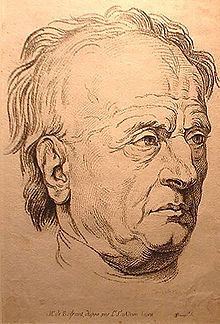Name Germain Boffrand Structures Chateau de Commercy | Role Architect | |
 | ||
Died March 19, 1754, Paris, France People also search for Emmanuel Here de Corny | ||
Hôtel de Soubise - Le Salon de la Princesse
Germain Boffrand ([ʒeʁmẽ bofʁɑ̃]) (16 May 1667 – 19 March 1754) was a French architect. A pupil of Jules Hardouin-Mansart, Germain Boffrand was one of the main creators of the precursor to Rococo called the style Regence, and in his interiors, of the Rococo itself. In his exteriors he held to a monumental Late Baroque classicism with some innovations in spatial planning that were exceptional in France His major commissions, culminating in his interiors at the Hotel de Soubise, were memorialised in his treatise Livre d'architecture, published in 1745, which served to disseminate the French "Louis XV" style throughout Europe.
Contents
- Htel de Soubise Le Salon de la Princesse
- Biography
- Last years and death
- Major commissions
- At Paris
- In Lorraine
- Religious architecture
- Civil engineering
- References
Biography
Born at Nantes, the son of a provincial architect, Boffrand went to Paris in 1681 to study sculpture in the atelier of Francois Girardon, before entering the large official practice of Jules Hardouin-Mansart. His uncle, Philippe Quinault, introduced him to prospective clients among the aristocracy of Paris and at Court. He was employed from 1689 (Kimball) on works in the Batiments du Roi under Mansart, notably at the Orangerie of Palace of Versailles and in Paris at Place Vendome, where Boffrand was among the draughtsmen responsible for the first designs (from 1686) and for the Convent of the Capucins, Hotel de Vendome From 1693 he was less employed and in 1699 he left the Batiments du Roi to commence work, at first in Lorraine and in the Netherlands, then after his return to Paris in 1709, for a distinguished private clientele in Paris, well disposed towards his audacious innovations, such as the oval forecourt of the Hotel Amelot de Gournay (1710–13), that were unthinkable in the royal works. In 1709, he was placed in charge of the interior apartments of the Hotel de Soubise, where he soon succeeded the architect Pierre-Alexis Delamair (1676–1745). None of his early interiors survive, largely replaced by his spectacular Rococo work of the years following 1735.
Boffrand was received by the Academie d'architecture in 1709. The following year he was among those employed in the additions to the Palais Bourbon. In 1732, he was appointed inspecteur general des ponts et chaussees and produced plans for restructuring Les Halles. He was a participant in the competition for the design of Place Louis XV. Named chief architect to the hopital general in 1724, he constructed in the Ile de la Cite a foundling hospital, the Hopital des Enfants Trouves (1727, demolished). Boffrand also worked for the hospitals at the Salpetriere, at Bicetre, and at the Hotel-Dieu. He built a series of hotels particuliers in Paris as speculative business enterprises. Of the inventive spatial arrangements in the hotel that swiftly became the Hotel Amelot de Gournay, Germain Brice remarked in his early 18th-century guidebook that "one will note some remarkable and daring lay-outs, which however appear rationally based, providing several amenities". Boffrand's pavilion of 1712-15 that inaugurated the new quarter of the Faubourg Saint-Honore was purchased and became the Hotel de Duras.
Abroad, Boffrand worked for the Duke of Lorraine (not yet a part of France), where he was appointed Premier Architecte to Duke Leopold in 1711, but little of significance remains. He also constructed a fountain and a hunt pavilion, Bouchefort, in the gardens of the schloss belonging to the Elector of Bavaria, Maximilian II Emmanuel. In 1724 Boffrand worked on site at Wurzburg with Balthasar Neumann, who had been consulting him in Paris, on the Prince-Bishop's Residenz (under construction 1719-1744). His designs were carried out in the main suite of rooms, where Fiske Kimball detected Boffrand's artistic control in the stuccowork by Johann Peter Castelli of Bonn.
Among the architects trained in his atelier were Francois Dominique Barreau de Chefdeville, Charles-Louis Clerisseau and Emmanuel Here de Corny, the architect of the Place Stanislas at Nancy. Boffrand's two sons collaborated in the office, both dying young, in 1732 and 1745.
Last years and death
Boffrand's folio, Livre d'architecture, was published in 1745. There are no surviving caches of his drawings. In January 1745 he was elected a Fellow of the Royal Society of London. Germain Boffrand died in Paris in 1754 at age 86.
Major commissions
The following commissions of Boffrand are largely taken from Fiske Kimball, The Creation of the Rococo, 1943.
